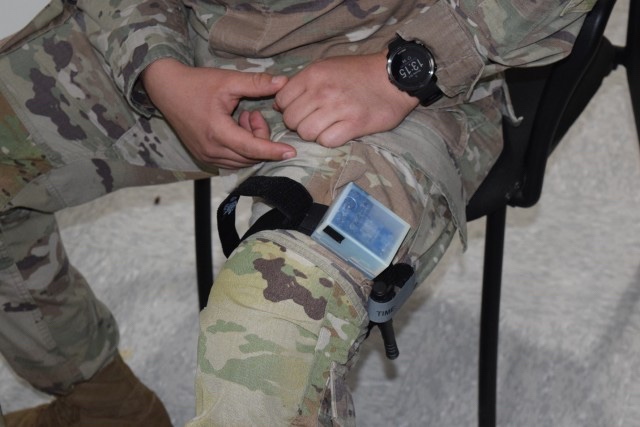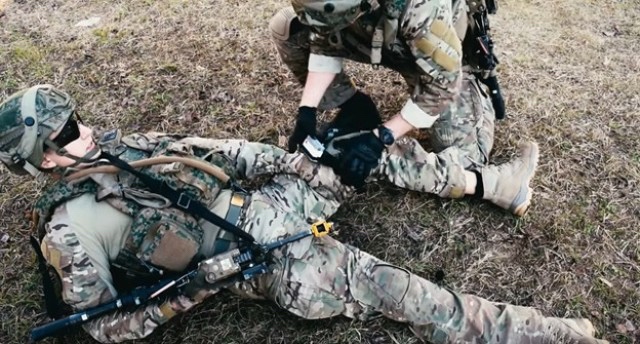AUSTIN, Texas — The Army partnered with medical experts from the Wellman Center for Photomedicine at Massachusetts General Hospital, a teaching hospital of Harvard Medical School, to test out a new tourniquet monitor designed to improve accuracy in tourniquet application.
The device underwent field scenario testing during the Army’s recent Army Expeditionary Warrior Experiment, or AEWE, held February 25 to March 7, 2022 at Fort Benning, Georgia, hosted by the Army Maneuver Capability Development and Integration Directorate’s Maneuver Battle Lab.
“The Wellman Center has a rich history of problem-driven science and engineering for DoD needs with success in translating technologies out to the warfighter,” said Dr. Conor Evans, the principal investigator on the Tourniquet Integrated Monitor project, also known as the TiMON.
The TiMON is a small, portable electronic device that enables real-time monitoring and evaluation of emergency tourniquet application.
The device is designed to work with any standard military windlass-based emergency tourniquet. The TiMON enhances a Soldier’s ability to control traumatic bleeding by providing intuitive visual feedback on the amount of pressure applied by the tourniquet, as well as a timer for tracking the tourniquet’s application duration.
As an additional indicator of effective tourniquet administration, variations of the device can track vitals such as limb tissue oxygenation.
Military personnel can utilize the TiMON to practice proper bleeding control methods and application of an emergency tourniquet in the field. The device, which was designed for use by dismounted infantry Soldiers, can be carried in a rucksack or attached to standard-issue emergency tourniquets prior to operations.

“AEWE was a great experience that allowed us to see our research project being utilized in a real-world setting by actual Soldiers,” said Dr. John Nguyen, who led the TiMON team’s first experience with AEWE. “We take each Soldier’s input very seriously, and our collaborative participation in AEWE helped to underline the importance of bleed control and triage under austere environments.”
While military personnel’s use of emergency tourniquets has helped to drastically reduce the incidence of combat hemorrhage deaths due to traumatic limb injuries, even trained personnel can struggle to judge effective tourniquet administration. This is especially true when service members are working under duress or in less-than-ideal settings, such as when visual and pulsatile feedback are obscured.
Over-tightening a tourniquet can result in tissue necrosis, while under-tightening a tourniquet might result in continuous bleeding. Long-term tourniquet use can result in additional ailments such as compartment syndrome and limb amputation. Furthermore, depending on dynamic physiological changes following trauma, a properly applied tourniquet may need to be evaluated over time and progressively modified.
The TiMON was created to address these challenges by giving precise and actionable feedback on applied emergency tourniquet pressure and duration without the need for a completely new emergency tourniquet design.
“Our TiMON clip attaches to existing combat tourniquets, which was a direct request from the DoD so that they could continue to use their preferred combat tourniquets,” said Evans. “Our work on the TiMON is largely independent from that of other devices currently on the market, and was specifically developed with application to the military in mind, making it fairly unique.”

The TiMON is now undergoing advanced prototype testing. It is fully functional, and the Wellman Center team is working to improve the technology and usability based on feedback from their participation in AEWE 2022. The DoD is funding the TiMON project, which is overseen by the Partners Human Research and the Henry M. Jackson Foundation for the Advancement of Military Medicine through the Uniformed Services University for Health Sciences. The TiMON project started in response to a request from retired Col. Michael Davis, then the head of the Combat Casualty Care Research Program, and was funded by the Transforming Technology for the Warfighter grant.
The Wellman Center for Photomedicine is currently iterating a new TiMON design that integrates elements recommended by Soldiers from their previous involvement in AEWE.
“After AEWE 2021, the main feedback was that the device should be made smaller. When applying the tourniquet, the device could take up real estate on the tourniquet and require the Soldier to place straps over the device, which could cause difficulty during application,” said TiMON research engineer Anna Wiatrowski.
“For AEWE 2022, the main goals in updating the device were to create a smaller device overall, incorporate a new pressure indicator and improve timer to track tourniquet wear,” Wiatrowski said.
“We had the incredible fortune to participate in both AEWE 2021 and 2022, as well as have the opportunity to carry out a civilian study in parallel,” said Evans. “The feedback we received from both AEWE events was extraordinary, and we see multiple routes forward for development. We sincerely thank the Army, the AEWE organizers and all the AEWE participants for these amazing opportunities.”
By Gloriann M. Martin, Army Futures Command


That’s an interesting looking pattern on that carrier